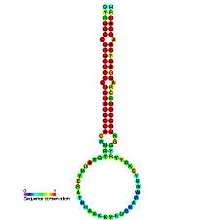mir-160 microRNA precursor family
In molecular biology, mir-160 is a microRNA that has been predicted or experimentally confirmed in a range of plant species including Arabidopsis thaliana (mouse-ear cress) and Oryza sativa (rice).[1] miR-160 is predicted to bind complementary sites in the untranslated regions of auxin response factor genes to regulate their expression.[2] The hairpin precursors (represented here) are predicted based on base pairing and cross-species conservation; their extents are not known. In this case, the mature sequence is excised from the 5' arm of the hairpin.
| mir-160 microRNA precursor family | |
|---|---|
 Predicted secondary structure and sequence conservation of mir-160 | |
| Identifiers | |
| Symbol | mir-160 |
| Rfam | RF00247 |
| miRBase | MI0000190 |
| miRBase family | MIPF0000032 |
| Other data | |
| RNA type | Gene; miRNA |
| Domain(s) | Eukaryota |
| GO | 0035195 0035068 |
| SO | 0001244 |
| PDB structures | PDBe |
Specifically, 3 of A. thaliana's 23 auxin-response factor genes are thought to be post-transcriptionally regulated by mir-160.[3][4] When one of these targets (ARF17) is manipulated to become miRNA-resistant, several developmental defects can be observed in the host plant.[3] This experiment has been repeated with another mir-160 target, ARF10, and results highlighted a regulatory role in post-embryonic development and seed germination.[5]
References
- "miRNA gene family: MIR160". mirBASE. University of Manchester. Archived from the original on 15 July 2012. Retrieved 5 September 2011.
- Rhoades MW, Reinhart BJ, Lim LP, Burge CB, Bartel B, Bartel DP (August 2002). "Prediction of plant microRNA targets". Cell. 110 (4): 513–20. doi:10.1016/S0092-8674(02)00863-2. PMID 12202040.
- Mallory AC, Bartel DP, Bartel B (May 2005). "MicroRNA-directed regulation of Arabidopsis AUXIN RESPONSE FACTOR17 is essential for proper development and modulates expression of early auxin response genes". The Plant Cell. 17 (5): 1360–75. doi:10.1105/tpc.105.031716. PMC 1091760. PMID 15829600.
- Liu X, Huang J, Wang Y, Khanna K, Xie Z, Owen HA, Zhao D (May 2010). "The role of floral organs in carpels, an Arabidopsis loss-of-function mutation in MicroRNA160a, in organogenesis and the mechanism regulating its expression". The Plant Journal. 62 (3): 416–28. doi:10.1111/j.1365-313X.2010.04164.x. PMID 20136729.
- Liu PP, Montgomery TA, Fahlgren N, Kasschau KD, Nonogaki H, Carrington JC (October 2007). "Repression of AUXIN RESPONSE FACTOR10 by microRNA160 is critical for seed germination and post-germination stages". The Plant Journal. 52 (1): 133–46. doi:10.1111/j.1365-313X.2007.03218.x. PMID 17672844.